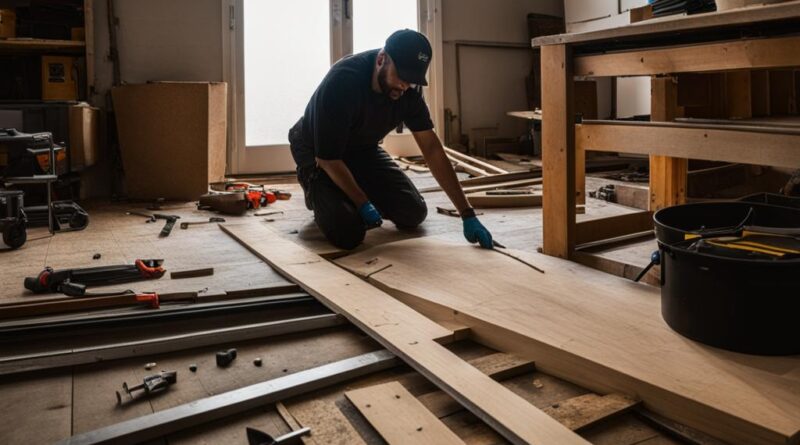Expert Guide on How to Fix Sagging Floors in Your Home
If you’re dealing with sagging floors in your home, it’s important to understand the causes and learn how to fix them. Sagging floors can indicate underlying issues with your foundation or structural support. This guide will provide you with step-by-step instructions on how to inspect your floors, identify the problem, and implement the necessary repairs.
Key Takeaways:
- Sagging floors can be caused by foundation issues, settling problems, and moisture damage.
- Inspect your floors, support posts, joists, and foundation for signs of damage or issues.
- Professional repair methods, such as underpinning or reinforcing, may be necessary for sagging floors.
- Ignoring sagging floors can lead to structural damage and increased risks.
- Seek professional assistance for accurate diagnosis and reliable solutions.
What Causes Sagging Floors?
Sagging floors in your home can be a concerning issue, but understanding the underlying causes is essential in addressing and fixing the problem. Several factors can contribute to sagging floors, including foundation issues, settling problems, and moisture damage. By identifying the signs and symptoms of sagging floors, you can take the necessary steps to rectify the situation and ensure the safety and stability of your home.
The Causes of Sagging Floors
Foundation Issues: One of the main culprits behind sagging floors is foundation problems. If the foundation of your home is weakened or damaged, it can lead to the shifting and sinking of the floor structure, resulting in sagging. Issues such as inadequate support, improper construction, or deterioration over time can all contribute to foundation-related floor problems.
Settling Problems: Another common cause of sagging floors is settling, which occurs when the soil beneath the foundation compresses or shifts. This can lead to uneven distribution of weight, causing the floors to sink or become uneven. Signs of settling may include cracks in the walls or floors, doors and windows that stick or no longer align, or gaps between the walls and ceiling.
| Causes of Sagging Floors | Signs of Sagging Floors |
|---|---|
| Foundation Issues | Cracks in walls or floors |
| Settling Problems | Doors and windows that stick or no longer align |
| Moisture Damage | Condensation on floors and walls |
Moisture Damage: Moisture can also play a role in causing sagging floors. Excess moisture or prolonged exposure to water can lead to rotting of the wooden joists and beams supporting your floors. Rot weakens the structural integrity of the wood, causing it to sag or become unstable. Signs of moisture damage may include condensation on the floors and walls, musty odors, or visible mold growth.
Understanding the causes of sagging floors is the first step in addressing the problem. By identifying the signs and symptoms early on, you can take appropriate measures to prevent further damage and ensure the stability of your home.
Inspecting Your Floors
When dealing with sagging floors in your home, conducting a thorough inspection is crucial in determining the underlying problem. By inspecting your floors, you can identify signs of foundation problems or structural damage that may be causing the sagging.
Start by checking the support posts in your basement or crawl space. Look for any signs of rot or structural damage, as these issues can weaken the support system. Next, examine the floor joists for cracks or rot, paying attention to any areas where pipes or wiring have been improperly cut, as these can weaken the joists. Additionally, inspect your foundation for signs of settlement, such as sticking windows and doors, or moisture damage, such as condensation.
By thoroughly inspecting your floors, support posts, floor joists, and foundation, you can gather valuable information about the extent and cause of the sagging. This information will be essential in determining the appropriate repair method for your specific situation.
Signs of Foundation Problems
During your inspection, it’s important to be aware of common signs of foundation problems. These can include:
- Cracks in the walls or floors
- Uneven or sloping floors
- Doors and windows that stick or don’t close properly
- Gaps between the walls and the floor or ceiling
If you notice any of these signs along with sagging floors, it’s recommended to consult with a professional for a more in-depth evaluation and to determine the best course of action for repairs.
Table: Common Signs of Foundation Problems
| Sign | Description |
|---|---|
| Cracks in the walls or floors | Visible cracks in the walls or floors, especially if they are wider than 1/4 inch. |
| Uneven or sloping floors | Floors that are not level or that slope noticeably. |
| Doors and windows that stick or don’t close properly | Doors and windows that are difficult to open or close, or that no longer fit properly in their frames. |
| Gaps between the walls and the floor or ceiling | Visible gaps between the walls and the floor or ceiling, indicating movement or settlement. |
Remember, inspecting your floors is the first step in addressing sagging floors in your home. By taking the time to thoroughly assess the condition of your support system and foundation, you can make informed decisions about the necessary repairs and ensure the long-term stability of your floors.
Repairing Sagging Floors in Basements and Crawl Spaces (Edges)
If your floors are sagging near the edges of your basement or crawl space, it may indicate a settlement problem. In this case, professionals can use underpinning methods like drilling or pushing long steel piers underneath your foundation to lift it back to its original position. These underpinning methods reach deep below your foundation and provide stability.
| Underpinning Method | Description | Advantages |
|---|---|---|
| Drilling Piers | This method involves drilling holes into the ground around the perimeter of your foundation. Long steel piers are then inserted into the holes and driven into the soil until they reach a stable depth. The piers are then connected to brackets attached to your foundation, providing support and lifting the sagging floors. | – Effective in stabilizing the foundation – Minimally invasive – Long-lasting solution |
| Pushing Piers | Push piers are another popular underpinning method for repairing sagging floors near the edges. Similar to drilling piers, this method involves driving long steel piers into the ground next to your foundation. The piers are hydraulically pushed into the soil until they reach stable strata, providing support and lifting the sagging floors. | – Provides immediate support – Can be installed in limited access areas – Cost-effective solution |
By employing these underpinning methods, professionals can restore the stability of your foundation and lift the sagging floors. It’s crucial to consult with a qualified contractor to assess your specific situation and determine the most suitable underpinning method for your basement or crawl space.
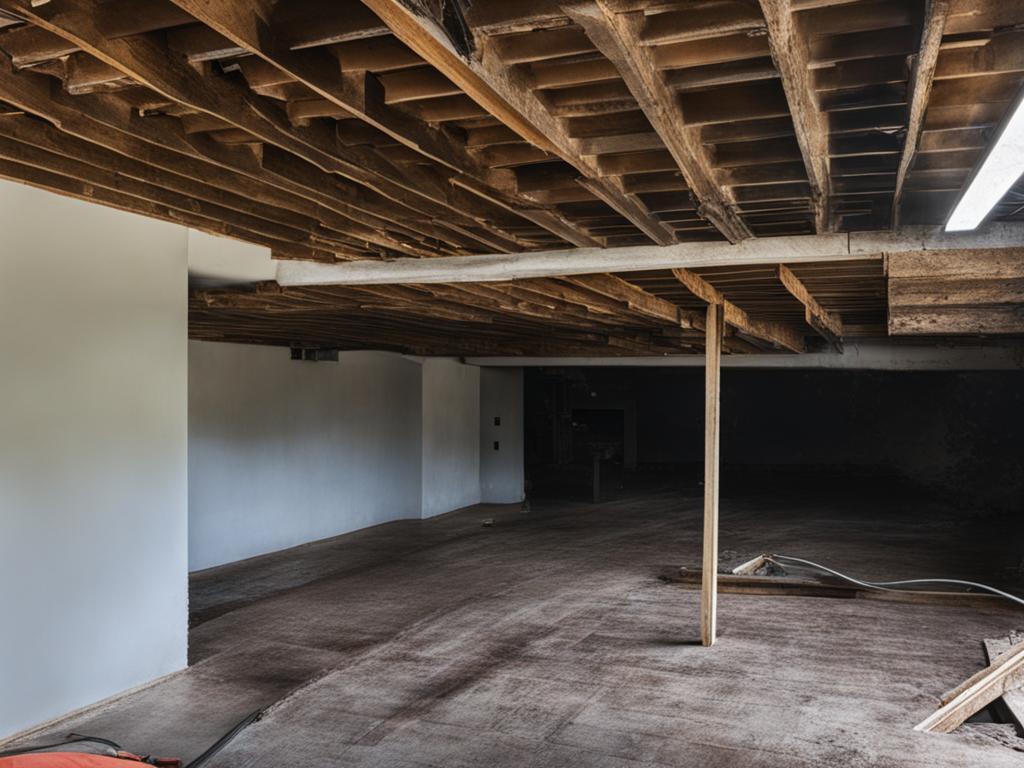
Signs of Sagging Floors
- Uneven or sloping floors
- Gaps between the floor and baseboards
- Cracks in the walls or ceilings
- Doors or windows that stick
- Noises like creaking or popping when walking on the floor
If you notice any of these signs in your basement or crawl space, it’s important to address the issue promptly to prevent further damage and ensure the safety of your home.
Repairing Sagging Floors in Basements and Crawl Spaces (Middle)
If your floors are sagging in the middle of your basement or crawl space, the issue may be with your floor joists or support beams. Professionals can reinforce or replace these components by installing steel jacks under the joists and gradually lifting them back to their original position. This method provides additional support and stability to your floors.
To reinforce the floor joists, the professionals will first assess the extent of the damage and determine the appropriate course of action. They may use hydraulic jacks to lift the sagging areas of the floor. Steel beams or posts are then installed beneath the joists to provide additional support. The jacks are gradually tightened to lift the floor back to its original level.
Once the floor has been successfully lifted, the professionals will secure the steel beams or posts in place to ensure long-term stability. This reinforcement not only fixes the sagging issue but also prevents further damage and improves the overall structural integrity of your basement or crawl space.
It is important to hire professionals for this repair process as they have the expertise and specialized equipment required to safely and effectively reinforce the floor joists. Attempting to repair sagging floors in basements or crawl spaces on your own can be dangerous and may lead to further damage. By entrusting the job to professionals, you can be confident that the repair work will be done correctly and that your floors will be restored to their original strength and stability.
| Pros of Professional Repair | Cons of DIY Repair |
|---|---|
| Expertise and knowledge in accurately diagnosing the problem | Lack of experience and understanding of underlying causes |
| Availability of specialized equipment and tools | Limited access to necessary tools and equipment |
| Ensures long-term stability and prevents further damage | Potential for incorrect repairs leading to additional issues |
| Professional guidance and advice throughout the repair process | Lack of professional guidance and support |
| Peace of mind knowing the job is done correctly | Risk of personal injury or further damage to property |
Repairing Sagging Floors in Slab Foundations (Edges)
If your home has a slab foundation and you notice sagging floors near the edges, it is likely due to sinking concrete. This can occur over time as the soil beneath the slab compresses or shifts. Fortunately, there are effective repair methods available to address this issue and restore stability to your floors.
One common technique used by professionals is the installation of push and helical piers. These piers are driven or drilled into the ground beneath the slab and provide support to lift the concrete back to its original position. By transferring the weight of the structure to load-bearing strata, these underpinning methods can effectively stabilize sagging floors and prevent further damage.
| Repair Method | Benefits |
|---|---|
| Push Piers | Provides a cost-effective solution |
| Helical Piers | Offers additional stability and load-bearing capacity |
It is important to note that these repair methods should be performed by experienced professionals. They have the knowledge and expertise to assess the extent of the damage, determine the appropriate piering system, and ensure the proper installation. By entrusting the repair process to professionals, you can have peace of mind knowing that your sagging floors are being properly addressed.
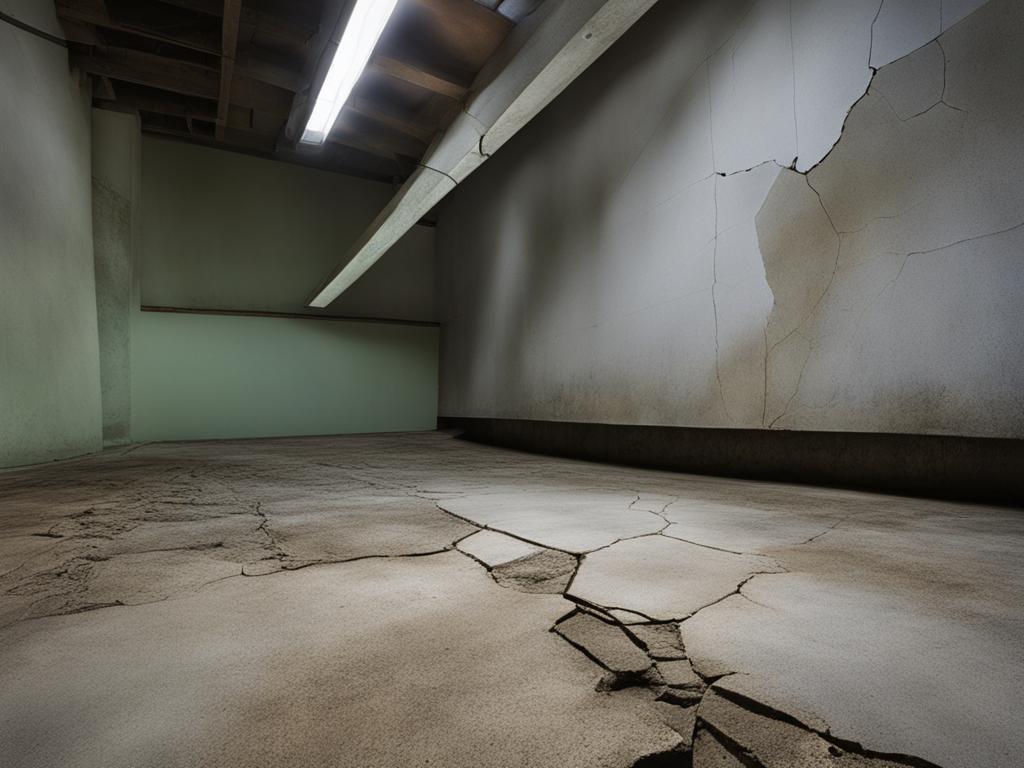
Repairing Sagging Floors in Slab Foundations (Middle)
If your floors are sagging in the middle of your home and you have a slab foundation, there may be a void underneath the concrete. This can occur due to water drainage or tree root growth. Professionals can drill small holes in the concrete and inject expanding polyurethane foam to fill the void and lift the slab back to its original position. This method provides stability and eliminates the sagging.
The process of repairing sagging floors in slab foundations starts with a thorough assessment of the underlying issue. Once the void is identified, professionals will drill strategic holes in the concrete at specific intervals. The expanding polyurethane foam is then injected into these holes, filling the void and gradually lifting the slab back to its original position.
The use of expanding polyurethane foam for repair works in slab foundations offers several advantages. The foam expands and hardens, creating a strong support system that effectively eliminates the sagging. It also helps to stabilize the concrete, preventing further damage and potential structural issues. This method is efficient and cost-effective, providing a long-lasting solution for sagging floors in slab foundations.
| Benefits of Repairing Sagging Floors in Slab Foundations (Middle) |
|---|
| Eliminates sagging and restores floor levelness |
| Stabilizes the concrete and prevents further damage |
| Efficient and cost-effective solution |
| Long-lasting results |
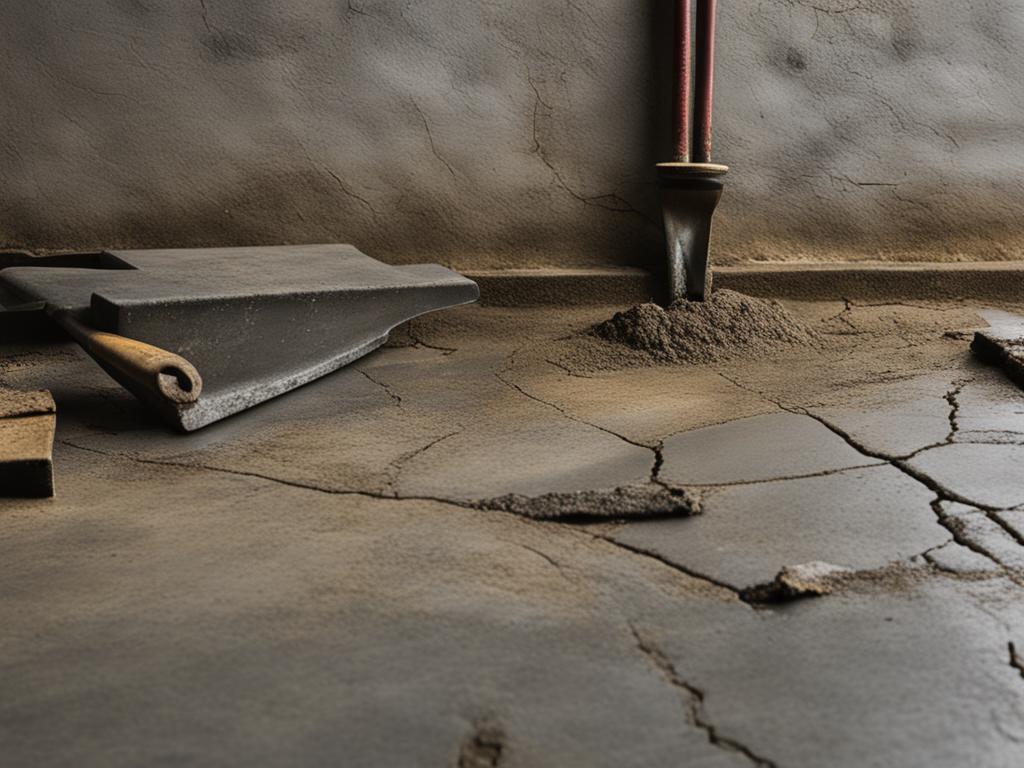
Professional Quote: “Repairing sagging floors in slab foundations requires precision and expertise. Our team uses advanced methods like injecting expanding polyurethane foam to fill voids and restore stability. By addressing the underlying issue, we ensure a safer and more secure living environment for our clients.” – [Professional Name], Floor Repair Expert
Insurance Coverage for Sagging Floors
When it comes to dealing with sagging floors in your home, one common question that arises is whether insurance coverage can help alleviate the financial burden of repairs. Unfortunately, in most cases, sagging floors caused by settlement, voids, or improper construction are not covered by standard homeowners insurance policies.
Homeowners insurance typically provides coverage for sudden and unexpected damages, such as those caused by natural disasters like floods or earthquakes. However, gradual issues like sagging floors are generally considered to be maintenance-related and are therefore not covered.
It’s important to review your insurance policy and consult with your insurance provider to understand what is covered for sagging floor repairs. Some insurance companies may offer additional coverage options specifically for foundation or structural issues, so it’s worth exploring these options to determine if they are suitable for your needs.
| Insurance Coverage for Sagging Floors | What’s Covered? | What’s Not Covered? |
|---|---|---|
| Standard Homeowners Insurance | – Sudden or unexpected damages – Natural disasters – Some foundation issues (depending on policy) |
– Sagging floors caused by settlement, voids, or improper construction – Gradual wear and tear |
| Additional Coverage Options | – Specific foundation or structural issues (depending on policy) – Enhanced coverage for repair or replacement – Additional peace of mind |
– Pre-existing conditions or damages – Maintenance-related issues |
While insurance coverage for sagging floors may be limited, it’s important to note that investing in professional inspection and repair services can help mitigate the risks associated with sagging floors. By addressing the issue promptly and implementing the necessary repairs, you can prevent further damage to your home and ensure the long-term stability and safety of your floors.
“It’s crucial to address sagging floors promptly to minimize risks.” – Insurance Expert
The Importance of Professional Inspection and Repair
When faced with sagging floors in your home, it’s essential to prioritize professional inspection and repair services. While DIY fixes may seem tempting, hiring experts offers numerous benefits that can ensure a safe and long-lasting solution. Professionals have the expertise and knowledge to accurately diagnose the underlying cause of sagging floors and implement the appropriate repairs.
One of the key advantages of professional inspection is the ability to identify any hidden issues that may be contributing to the sagging floors. These experts can conduct a thorough assessment of your foundation, floor joists, and support beams, ensuring that no problems go unnoticed. By addressing these underlying issues, professionals can provide comprehensive repairs that not only fix the sagging floors but also prevent future damage.
Another benefit of professional repair services is the use of specialized techniques and equipment. Professionals have access to advanced tools and materials that are specifically designed for floor repair. They can reinforce floor joists, install additional support beams, or use underpinning methods such as steel piers to restore the structural integrity of your floors. These professional-grade solutions ensure optimal stability and long-term durability.
“Hiring professionals for sagging floor repairs can prevent further damage, ensure long-term stability, and provide peace of mind.”
Finally, professional repairs offer peace of mind. By entrusting your sagging floors to experts, you can rest assured that the job will be done correctly and safely. Professionals adhere to industry standards and regulations, ensuring that the repairs meet the highest quality and safety standards. This not only protects your investment in the home but also provides a safe living environment for you and your family.
Overall, professional inspection and repair services are crucial when dealing with sagging floors. By relying on experts, you can benefit from their knowledge, specialized techniques, and peace of mind, ensuring that your floors are restored to their original stability and strength.
The Dangers of Ignoring Sagging Floors
Ignoring sagging floors in your home can lead to serious consequences and pose significant risks of structural damage. Sagging floors indicate underlying issues with your foundation or structural support, which, if left unaddressed, can worsen over time and compromise the stability of your entire home.
Sagging floors weaken the overall structure of your home, increasing the risk of collapse and potential injuries. As the floors sink and become more unstable, they can put additional stress on the rest of the house, causing walls to shift and potentially leading to further damage. In the event of a natural disaster, a home with sagging floors may be more vulnerable to extensive destruction.
By ignoring sagging floors, you not only jeopardize the safety of your family but also risk incurring additional expenses in the long run. Unaddressed structural issues may lead to more extensive repairs and costly fixes down the line. It’s crucial to take proactive steps to address sagging floors promptly and minimize the risks associated with structural damage.
“Ignoring sagging floors can lead to increased risks of damage and compromise the overall stability of your home.”
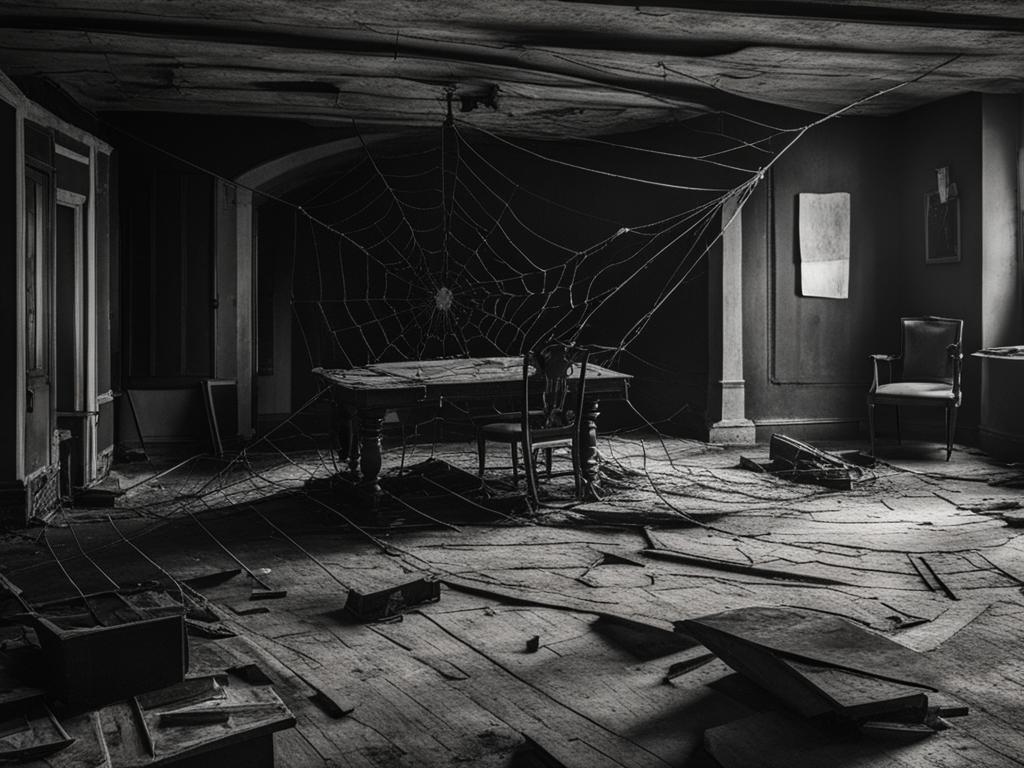
| Risks of Ignoring Sagging Floors | Consequences |
|---|---|
| Increased risk of collapse | Potential injuries and harm to occupants |
| Compromised structural integrity | Shifting walls and further damage to the home |
| Higher vulnerability to natural disasters | Increased risk of extensive destruction |
| Additional expenses in the long run | More extensive repairs and costly fixes |
The Benefits of Repairing Sagging Floors
Repairing sagging floors offers numerous benefits. By restoring the floors’ stability, you create a safer living environment for you and your family. Repaired floors can bear more weight and support heavy objects without the risk of structural failure. Additionally, fixing sagging floors helps protect your investment in the home and may increase its resale value. It provides peace of mind knowing that the flooring is reliable and won’t pose any hazards.
When sagging floors are left unaddressed, they can lead to a variety of safety concerns. Continued weakening of the floors can eventually lead to collapse, putting occupants at risk of injury. Sagging floors can also place additional stress on the rest of the home’s structure, causing walls to shift and compromising the overall integrity. By taking the necessary steps to repair sagging floors, you can minimize these risks and ensure a safer living environment.
In addition to improved safety, repairing sagging floors enhances the overall stability of your home. When floors are properly repaired and reinforced, they regain their ability to support the weight of furniture, appliances, and everyday activities. This added stability allows you to use your home more comfortably, without worrying about potential structural failures. Moreover, a structurally stable home provides peace of mind, knowing that you and your loved ones are well-protected.
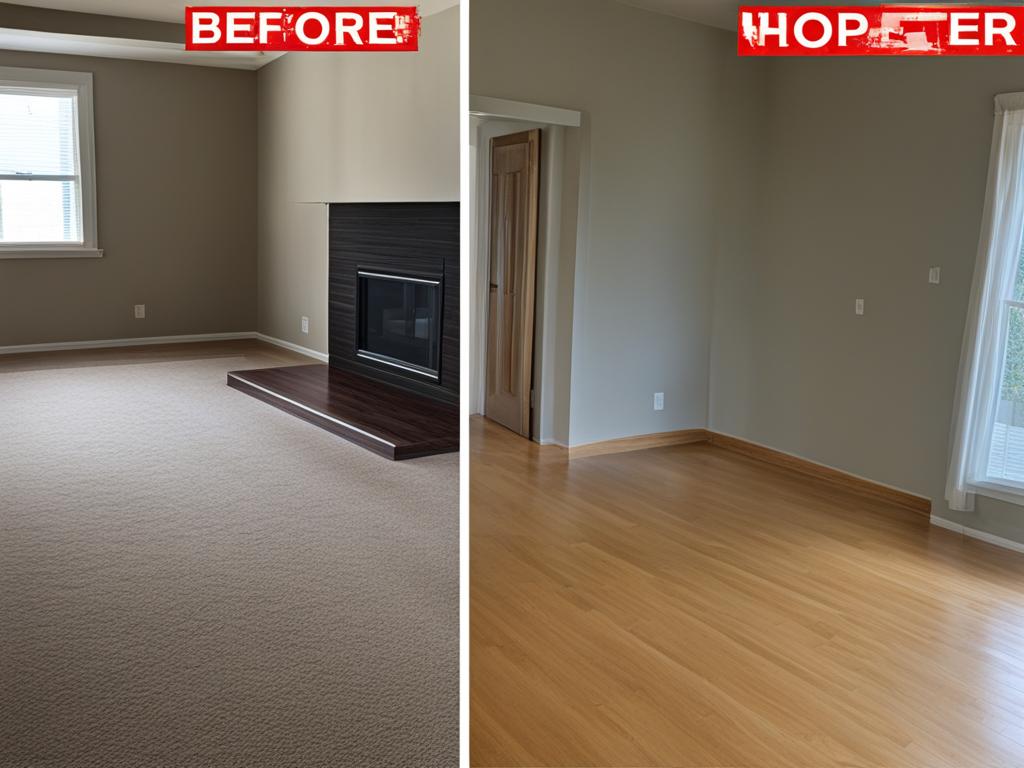
Key Benefits of Repairing Sagging Floors:
- Enhanced safety for you and your family
- Improved stability of the entire home
- Increased weight-bearing capacity of the floors
- Protection of your investment and potential increase in resale value
- Peace of mind knowing that the flooring is reliable and secure
Repairing sagging floors not only improves the safety and stability of your home, but it also offers long-term benefits in terms of protecting your investment and increasing its value. By addressing sagging floors promptly, you can ensure a safer living environment and enjoy the peace of mind that comes with a structurally sound home.
Conclusion
In conclusion, fixing sagging floors is crucial for maintaining the stability and safety of your home. To ensure accurate diagnosis and reliable solutions, it is highly recommended to seek professional floor repair services. Professionals have the expertise and knowledge to identify the underlying causes of sagging floors and implement the appropriate repairs.
Ignoring sagging floors can lead to increased risks of damage and compromise the overall structural integrity of your home. By taking proactive steps to address sagging floors, you can create a safe and secure living environment for you and your family.
Remember, restoring the stability of your floors not only enhances the safety of your home but also protects your investment. Repaired floors can bear more weight and support heavy objects without the risk of structural failure. This can increase the resale value of your home and provide peace of mind knowing that your flooring is reliable and won’t pose any hazards.
Whether it’s sagging floors in basements, crawl spaces, or slab foundations, professional floor repair services can provide the necessary expertise and solutions. So, don’t hesitate to seek professional assistance to fix your sagging floors and ensure a safe and stable living environment for years to come.
FAQ
What are the causes of sagging floors?
Sagging floors can be caused by foundation issues, settling problems, and moisture damage.
What are the signs of sagging floors?
Signs of sagging floors include sticking windows and doors and condensation on the floors and walls.
How do I inspect my floors for sagging?
To inspect your floors, check support posts, floor joists, and foundation for signs of damage or moisture issues.
How can I repair sagging floors in basements and crawl spaces near the edges?
Professionals can use underpinning methods like steel piers to lift the foundation back to its original position.
How can I repair sagging floors in basements and crawl spaces in the middle?
Professionals can reinforce or replace floor joists and support beams using steel jacks to lift them back into place.
How can I repair sagging floors in slab foundations near the edges?
Underpinning methods like push and helical piers can be used to lift the concrete back to its original position.
How can I repair sagging floors in slab foundations in the middle?
Professionals can drill holes and inject expanding foam to fill voids under the concrete and lift the slab.
Does homeowners insurance cover sagging floor repairs?
In most cases, sagging floors caused by settlement or improper construction are not covered. Separate insurance may be required for sudden or unexpected damage.
Why is professional inspection and repair important for sagging floors?
Professionals can accurately diagnose the problem, provide reliable solutions, and ensure that the repairs are done correctly, preventing further damage and ensuring long-term stability.
What are the dangers of ignoring sagging floors?
Ignoring sagging floors can lead to increased risks of collapse, compromised structural integrity, and vulnerability to extensive damage during natural disasters.
What are the benefits of repairing sagging floors?
Repairing sagging floors creates a safer living environment, increases weight-bearing capacity, protects your investment, and potentially increases the resale value of your home.

